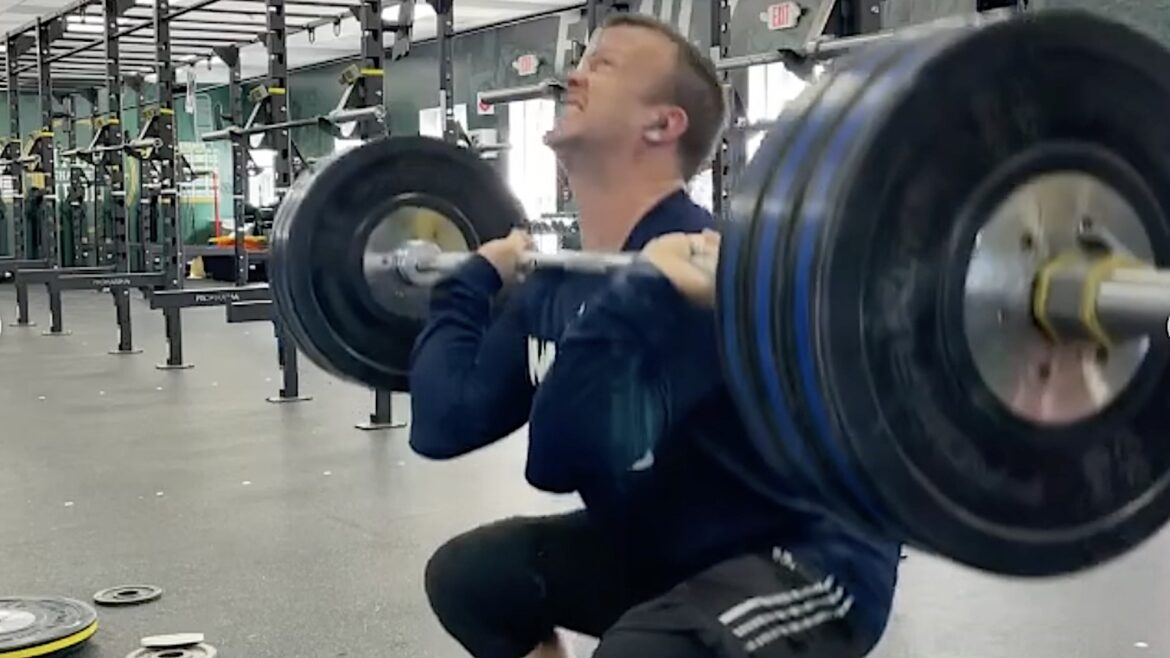Advanced lifters should only test their one-rep max a few times per year.
Olympic weightlifting demands power, precision, and flawless technique across two lifts: the snatch and the clean & jerk. Raw strength is at the heart of these movements, often measured through the one-rep max (1RM), a benchmark for assessing a lifter’s maximum capacity. (1)
Olympic weightlifting coach Brian Chambers and 2025 National University Champion and coach Calvin Lackey shared their insights on how often athletes should test the limits of their strength:
Maxing Out vs. Going Heavy
Understanding the difference between maxing out and lifting heavy is crucial. “They are not the same. They are often misconstrued, which can lead to going too heavy in training or not going heavy at the right time,” Chambers explained.
Going Heavy
Lackey parallels bodybuilding and the fitness industry, highlighting the contrast between science-driven lifters and traditional gym enthusiasts. “They’re the same thing in weightlifting. There’s the person who’s really by the books, trying to recover well, and there’s the guy who’s maxing out all the time,” he expressed.
“Going heavy” can have various interpretations. For some, it might mean pushing through a maximum set of 10 reps; for others, it could mean testing limits with a single, heavy rep. Each approach impacts the body differently.
Maxing Out
“Maxing out” generally refers to an individual’s 1RM. Lackey delved into the size principle of muscle recruitment. Known as Henneman’s size principle, this theory explains that smaller motor units are activated first, with larger motor units gradually engaged as the demand for force increases. (2)
As force increases, the body recruits larger muscle fibers. This process begins with type I fibers, which are highly endurance-focused but generate low force. Type II muscle fibers produce significantly more force but fatigue much faster.
During high-force activities, all muscle fiber types are activated, placing considerable strain on motor units and the neural pathways that control them. This is why consistently pushing to maximum effort can take a toll on the body. Understanding this can help balance intensity and recovery.
Strength Reserve
Strength reserve is key in determining how often someone can max out or lift heavy during training, which aligns with the size principle. Essentially, the greater the force you can generate, the less recovery is needed. Olympic lifts don’t require as much force production as other movements, such as traditional strength lifts.
A higher strength reserve allows athletes to lift at maximum effort or go heavy more frequently in Olympic lifts.
Testing a 1RM
A 1RM calculator is an effective tool for estimating your 1RM. While AMRAPs (as many reps as possible) can also provide a reasonable estimate, they’re not ideal for technical lifts like the snatch or clean & jerk. They’re better suited for strength-based exercises.
Progress can be measured with AMRAPs for sets of five or by attempting a 1RM for multiple reps. Achieving a high percentage of your max for multiple reps is another clear indicator of improvement.
When testing personal weightlifting bests, practice patience. The approach to max testing differs between strength and Olympic lifts and also varies based on the experience level. Tailoring your strategy to specific goals and skill set will likely yield the best results.
Frequency of Weightlifting Max Lifts
To monitor progress, beginners can effectively test their 1RM every three to five weeks during a training block.
Testing doesn’t always require a 1RM, though. During a training block, beginners can aim for a two or three-rep max on Olympic lifts, providing a broader measure of strength development. “That’s a better way to progress long-term than to test new maxes at the end of every month,” Lackey said.
For Intermediates
Intermediate lifters can test their 1RM every nine to 12 weeks within a training cycle, roughly four to five times a year. This frequency may vary by individual.
Intermediate training approaches can be structured into distinct blocks; some weeks focused on building strength and others dedicated to Olympic lifts. Lifters can assess their maximum performance at the end of a nine to 12-week cycle.
For Advanced Lifters
Experienced lifters can assess their 1RM two to three times per year during major training phases. These phases could encompass an entire strength-focused mesocycle.
“Nine weeks of back squats, nine weeks of clean deadlifts, nine weeks of front squat, and then a huge max out,” Lackey prescribed.
Advanced lifters typically reach a max lift every 36 weeks, or roughly four to six months. The challenge is the immense effort and training required to add a small amount of weight to max lifts.
Before deciding to max out, consider the underlying rationale. Is it driven by a perceived loss of strength, insecurity, or gaps in training? Reflect carefully before pushing for a max lift.
More Weightlifting Content
References
- Seo, D. I., Kim, E., Fahs, C. A., Rossow, L., Young, K., Ferguson, S. L., Thiebaud, R., Sherk, V. D., Loenneke, J. P., Kim, D., Lee, M. K., Choi, K. H., Bemben, D. A., Bemben, M. G., & So, W. Y. (2012). Reliability of the one-repetition maximum test based on muscle group and gender. Journal of sports science & medicine, 11(2), 221–225.
- Senn, W., Wyler, K., Clamann, H. P., Kleinle, J., Lüscher, H. R., & Müller, L. (1997). Size principle and information theory. Biological cybernetics, 76(1), 11–22. https://doi.org/10.1007/s004220050317
Featured image: @timwalkerlift on Instagram
